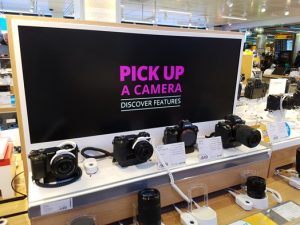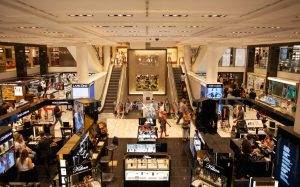Digital signage ruffles the waters of every industry it touches, be it healthcare, travel, education, or hospitality. When it comes to digital signage in retail, however, its impact can be classified as nothing less than a tidal wave. We take a closer look at some of the most impactful successes of digital signage in retail, explaining why it makes for such a remarkable disruption in this industry.
You’ll see that this disruption is in no way negative, but rather enhances the customer experience, eases the sales advisers’ job, increases the amount of products able to be showcased and smoothens business operations overall. While digital signage is headed to become a mandatory tool for good customer experience and frictionless workflows, it’s never been more accessible, regardless of the size of your store or budget.
1. Shopping becomes more convenient
Of the many ways the customer experience benefits, the top will always be ease and increase. Ease of finding, inquiring about, trying on and purchasing of a product, and increase of quantity of items to peruse and sample.
One excellent example for demonstrating ease and increase is the use of so-called virtual mirrors. These allow the customer to try on make-up, accessories, and clothes without going through the hassle of changing into every single outfit. It might not be 100% visually accurate to what the item would look like when it’s worn or applied, but it provides a good-enough preview to determine like or dislike. If the look of a particular suit on you agrees with your initial impression, you can still try it on in real life, skipping the hassle of trying out ten others.
While this use of digital signage in retail might be advanced, or expensive for that matter, it is, of course, not the only way to make the shopping experience more convenient. Digital displays used to direct users, announce sales or special offers, or showcase the newest collection are all excellent methods and have been practiced in analog form with posters or boards for a long time. Digital displays are merely the newest upgrade.
As times advance, customers expect even more. Going to the mall has always been more than just spending money on a product you need. People want shopping to be convenient, yes, but also entertaining, engaging, and overall enjoyable. For many, it’s a relaxing and social pastime.
2. Readily available product information
We’ve treated product information as a means to make the shopping experience more convenient. Product information is another field where digital signage can shine. Apart from the aforementioned clothing preview in a virtual mirror, giving your customer the means to examine the ins and outs of a product can make quite a difference. If a shopper wants to know pricing, size, color combinations, stock, availability, care instructions, ingredients, certificates of origin, manufacturing conditions, or technical data, a display can provide it all.
With a sophisticated display setup, a customer may browse items currently out of stock or soon to arrive. They may assemble made-to-order items: the ultimate personalization! Not only does this give your customers a wider range of products, it can also lower your needed retail space. Thus has a direct effect on your bottom line. You only need to hang out a few samples per style with the main inventory in the back ready to be brought out on request.
Besides displays alone, providing product information can blend with the physical world and make the shopping experience more interconnected. A display which relays a spot and product information of the item you are eyeing as soon as you inspect it up closer will certainly intrigue for its relevance. How can the digital display know where you look? Sensors or chips on the item, or its stand, trigger the digital display when a customer picks up the product. We’ve written about this use case before in our article of digital signage impacting the travel industry. In many cases, travel overlaps with retail and hospitality.
3. Even grocery stores adopt digital signage
Grocery stores are often the last in line to adopt any major change in their industry. They aren’t the ones to easily pursue short-lived trends, techniques, or tools requiring profound investments. Traditionally, grocery store profit margins are one of the lowest per item. It’s only through volume that they can actually make profits. These low profit margins don’t allow for experimenting with changes on a whim.
Grocery stores will adopt a change and take a new direction only if absolutely necessary and proven to work; thus, seeing them adopt digital signage speaks volumes. It’s certainly a positive note for digital signage, showing how it’s become an integrated component of retail. Another positive, but this time for grocery stores, is that digital signage is more affordable and usable than ever. With a growing offer from hardware and software providers, it’s never been easier or cheaper to implement.
4. Corporate communications flow better
Your floor staff are the face of your brand on the personal level with the customer. They have goals to achieve for the brand by providing excellent customer service, being experts about the products, navigating through the store, having an excellent attitude, adapting to the customer, and being communicative. Digital signage can help them achieve these goals, even being communicative, to a degree. Here’s how!
Digital signage in retail can keep your staff up to speed with new products, pricing, or policies of the store. It’s even more vital when it comes to special offers which can change so frequently, it’s hard to keep track. Retail workers don’t sit at their desks all day and are able to catch up on their emails. In many cases, retail workers don’t even get corporate email addresses. This makes it hard to reach them with updates. Brick and mortar is already fighting an uphill battle against online retailers where every information is available at the click of a button and from the convenience of their home. One part that still makes the physical shopping experience appealing is getting personal consultation.
Little can be worse to your brand’s reputation than a clueless sales adviser being caught off guard by news customers know before them. It’s headquarter’s job to give the floor staff the tools to delight and advise the customers.
New campaign info can be shared through displays on the floor space where they are also visible to the customer. For more sensitive and strategic information only meant for those on the inside, displays in the break or back room help brief and keep your staff up to speed before stepping on the sales floor and feeling confident that they can carry out their job to their best abilities.
Is digital signage truly so impactful?
If your employees are well-informed, they can execute their tasks better. They’re also more confident in communicating with customers and feel reassured that corporate is working with and not against them. This shows how utilizing digital signage in retail does more than only boost the customer experience for a happier customer base. It also makes for a more loyal and better prepared sales force.
Digital signage has great potential in retail as it covers both the internal and external side of the retail business extremely well. This is why its impact is fully justified.










